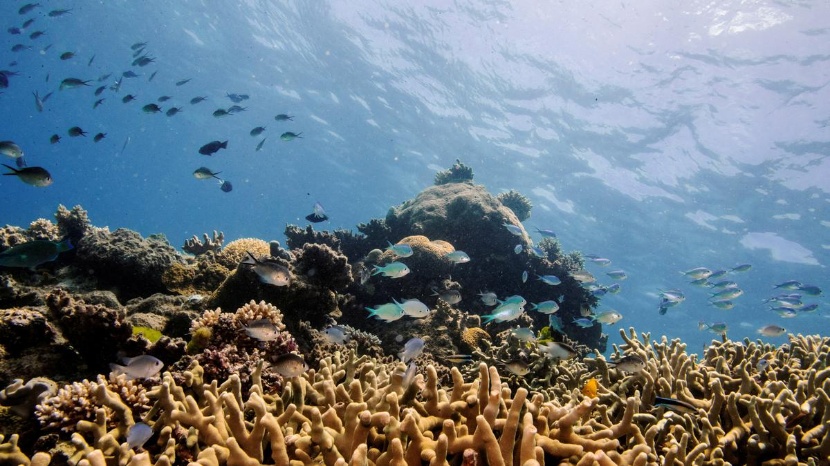Important Facts For Prelims
Cryomesh and Frozen Coral
- 26 Dec 2022
- 7 min read
Why in News?
While working on Australia’s Great Barrier Reef, scientists have successfully trialed a new method for freezing and storing coral in their first trial.
What is the Need for Freezing Coral?
- As rising ocean temperatures destabilize the delicate ecosystems of Coral, therefore scientists are striving to protect coral reefs.
- The Great Barrier Reef has suffered four bleaching events in the last seven years, including the first-ever bleach during a La Niña phenomenon, which typically brings cooler temperatures.
- Scientists used the cryomesh to freeze coral larvae at the Australian Institute of Marine Sciences (AIMS).
What is the Methodology of Freezing Coral?
- Cryomesh:
- Cryomesh was devised by a team from the University of Minnesota’s College of Science and Engineering.
- This is lightweight and can be manufactured cheaply.
- It better preserves coral and has the properties of cryoplates.
- The mesh technology will help store coral larvae at -196°C (-320.8°F).
- Significance:
- This cryogenically frozen coral can be stored and later reintroduced to the wild.
- But current process requires sophisticated equipment including lasers, however a new lightweight “cryomesh” can be manufactured cheaply and better preserves coral.
What are Coral Reefs?
- About:
- Corals are marine invertebrates or animals which do not possess a spine. In scientific classification, corals fall under the phylum Cnidaria and the class Anthozoa.
- Coral is made up of genetically identical organisms called polyps. These polyps have microscopic algae called zooxanthellae living within their tissues.
- The corals and algae have a mutualistic relationship.
- The coral provides the zooxanthellae with the compounds necessary for photosynthesis.
- In return, the zooxanthellae supply the coral with organic products of photosynthesis, like carbohydrates, which are utilized by the coral polyps for synthesis of their calcium carbonate skeletons.
- In addition to providing corals with essential nutrients, zooxanthellae are responsible for the unique and beautiful colors of corals.
- They are also called the “rainforests of the seas”.
- There are two types of corals:
- Hard, shallow-water corals—the kind that builds reefs.
- Soft corals and deepwater corals that live in dark cold waters.
- Significance:
- They support over 25% of marine biodiversity even though they take up only 1% of the seafloor.
- The marine life supported by reefs further fuels global fishing industries.
- Besides, coral reef systems generate USD 2.7 trillion in annual economic value through goods and service trade and tourism.
What is the Great Barrier Reef?
- It is the world’s most extensive and spectacular coral reef ecosystem composed of over 2,900 individual reefs and 900 islands.
- The reef is located in the Coral Sea (North-East Coast), off the coast of Queensland, Australia.
- It can be seen from outer space and is the world’s biggest single structure made by living organisms.
- It was selected as a World Heritage Site in 1981.
UPSC Civil Services Examination, Previous Year Question (PYQ)
Prelims
Q.1 Which of the following have species that can establish a symbiotic relationship with other organisms? (2021)
- Cnidarians
- Fungi
- Protozoa
Select the correct answer using the code given below.
(a) 1 and 2 only
(b) 2 and 3 only
(c) 1 and 3 only
(d) 1, 2 and 3
Ans: (d)
Exp:
- Symbiosis is a close ecological relationship between the individuals of two (or more) different species.
- The symbiotic association between the invertebrate phylum Cnidaria (Coelenterate) and the unicellular dinoflagellate algae, called zooxanthellae, is very common and symbolises mutualistic interaction. The beautiful colours of coral reefs is due to the different coloured algae symbiotically attached with the coelenterata. Hence, 1 is correct.
- Mycorrhizae are symbiotic relationships that are formed between fungi and plants. The fungi colonize the root system of a host plant, providing increased water and nutrient absorption capabilities while the plant provides the fungus with carbohydrates formed from photosynthesis. Hence, 2 is correct.
- Symbiosis in protozoa mostly represents a close mutualistic association between a protozoan and unicellular symbiont (bacteria, cyanobacteria or/ and unicellular algae) or protozoans and a multicellular organism (ruminants, lower termites, wood-eating cockroaches and plants).
- Termites have a mutualistic relationship with protozoa that live in the insect’s gut. The termite benefits from the ability of bacterial symbionts within the protozoa to digest cellulose. The termite itself cannot do this, and without the protozoa, it would not be able to obtain energy from its food (cellulose from the wood it chews and eats). Hence, 3 is correct.
- Therefore, option (d) is the correct answer.
Q.2 Consider the following statements: (2018)
- Most of the world’s coral reefs are in tropical waters.
- More than one-third of the world’s coral reefs are located in the territories of Australia, Indonesia and Philippines.
- Coral reefs host far more number of animal phyla than those hosted by tropical rainforests.
Which of the statements given above is/are correct?
(a) 1 and 2 only
(b) 3 only
(c) 1 and 3 only
(d) 1, 2 and 3
Ans: (d)
Q.3 Which of the following have coral reefs? (2014)
- Andaman and Nicobar Islands
- Gulf of Kachchh
- Gulf of Mannar
- Sunderbans
Select the correct answer using the code given below:
(a) 1, 2 and 3 only
(b) 2 and 4 only
(c) 1 and 3 only
(d) 1, 2, 3 and 4
Ans: (a)
Mains
Q. Assess the impact of global warming on the coral life system with examples. (2019)







